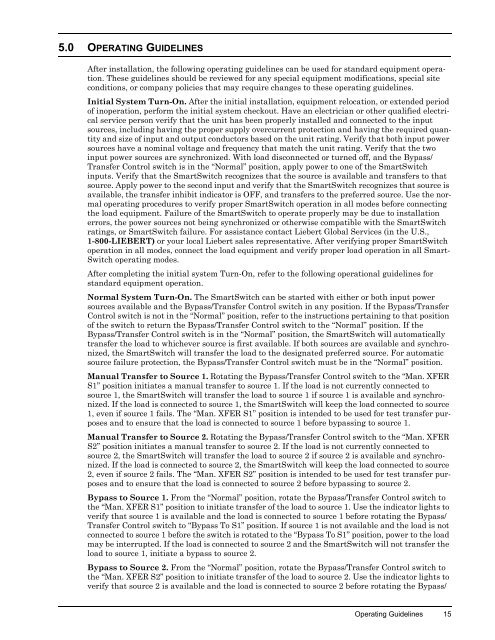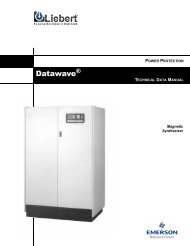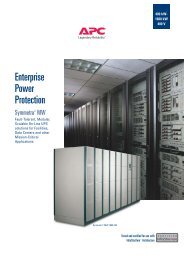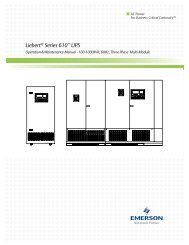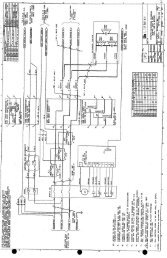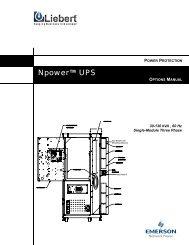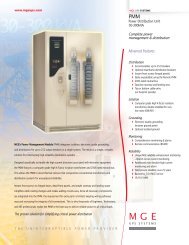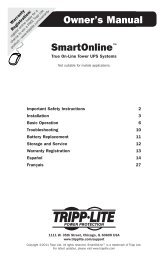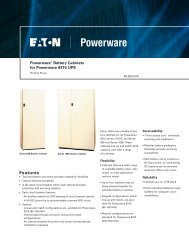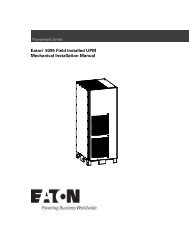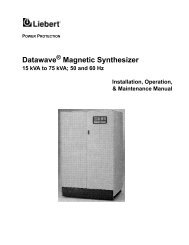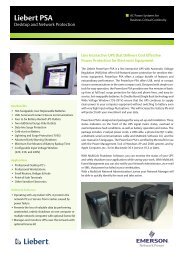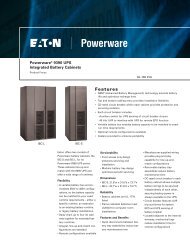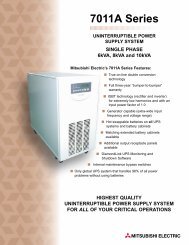Liebert SmartSwitch - Emerson Network Power
Liebert SmartSwitch - Emerson Network Power
Liebert SmartSwitch - Emerson Network Power
Create successful ePaper yourself
Turn your PDF publications into a flip-book with our unique Google optimized e-Paper software.
5.0 OPERATING GUIDELINES<br />
After installation, the following operating guidelines can be used for standard equipment operation.<br />
These guidelines should be reviewed for any special equipment modifications, special site<br />
conditions, or company policies that may require changes to these operating guidelines.<br />
Initial System Turn-On. After the initial installation, equipment relocation, or extended period<br />
of inoperation, perform the initial system checkout. Have an electrician or other qualified electrical<br />
service person verify that the unit has been properly installed and connected to the input<br />
sources, including having the proper supply overcurrent protection and having the required quantity<br />
and size of input and output conductors based on the unit rating. Verify that both input power<br />
sources have a nominal voltage and frequency that match the unit rating. Verify that the two<br />
input power sources are synchronized. With load disconnected or turned off, and the Bypass/<br />
Transfer Control switch is in the “Normal” position, apply power to one of the <strong>SmartSwitch</strong><br />
inputs. Verify that the <strong>SmartSwitch</strong> recognizes that the source is available and transfers to that<br />
source. Apply power to the second input and verify that the <strong>SmartSwitch</strong> recognizes that source is<br />
available, the transfer inhibit indicator is OFF, and transfers to the preferred source. Use the normal<br />
operating procedures to verify proper <strong>SmartSwitch</strong> operation in all modes before connecting<br />
the load equipment. Failure of the <strong>SmartSwitch</strong> to operate properly may be due to installation<br />
errors, the power sources not being synchronized or otherwise compatible with the <strong>SmartSwitch</strong><br />
ratings, or <strong>SmartSwitch</strong> failure. For assistance contact <strong>Liebert</strong> Global Services (in the U.S.,<br />
1-800-LIEBERT) or your local <strong>Liebert</strong> sales representative. After verifying proper <strong>SmartSwitch</strong><br />
operation in all modes, connect the load equipment and verify proper load operation in all Smart-<br />
Switch operating modes.<br />
After completing the initial system Turn-On, refer to the following operational guidelines for<br />
standard equipment operation.<br />
Normal System Turn-On. The <strong>SmartSwitch</strong> can be started with either or both input power<br />
sources available and the Bypass/Transfer Control switch in any position. If the Bypass/Transfer<br />
Control switch is not in the “Normal” position, refer to the instructions pertaining to that position<br />
of the switch to return the Bypass/Transfer Control switch to the “Normal” position. If the<br />
Bypass/Transfer Control switch is in the “Normal” position, the <strong>SmartSwitch</strong> will automatically<br />
transfer the load to whichever source is first available. If both sources are available and synchronized,<br />
the <strong>SmartSwitch</strong> will transfer the load to the designated preferred source. For automatic<br />
source failure protection, the Bypass/Transfer Control switch must be in the “Normal” position.<br />
Manual Transfer to Source 1. Rotating the Bypass/Transfer Control switch to the “Man. XFER<br />
S1” position initiates a manual transfer to source 1. If the load is not currently connected to<br />
source 1, the <strong>SmartSwitch</strong> will transfer the load to source 1 if source 1 is available and synchronized.<br />
If the load is connected to source 1, the <strong>SmartSwitch</strong> will keep the load connected to source<br />
1, even if source 1 fails. The “Man. XFER S1” position is intended to be used for test transfer purposes<br />
and to ensure that the load is connected to source 1 before bypassing to source 1.<br />
Manual Transfer to Source 2. Rotating the Bypass/Transfer Control switch to the “Man. XFER<br />
S2” position initiates a manual transfer to source 2. If the load is not currently connected to<br />
source 2, the <strong>SmartSwitch</strong> will transfer the load to source 2 if source 2 is available and synchronized.<br />
If the load is connected to source 2, the <strong>SmartSwitch</strong> will keep the load connected to source<br />
2, even if source 2 fails. The “Man. XFER S2” position is intended to be used for test transfer purposes<br />
and to ensure that the load is connected to source 2 before bypassing to source 2.<br />
Bypass to Source 1. From the “Normal” position, rotate the Bypass/Transfer Control switch to<br />
the “Man. XFER S1” position to initiate transfer of the load to source 1. Use the indicator lights to<br />
verify that source 1 is available and the load is connected to source 1 before rotating the Bypass/<br />
Transfer Control switch to “Bypass To S1” position. If source 1 is not available and the load is not<br />
connected to source 1 before the switch is rotated to the “Bypass To S1” position, power to the load<br />
may be interrupted. If the load is connected to source 2 and the <strong>SmartSwitch</strong> will not transfer the<br />
load to source 1, initiate a bypass to source 2.<br />
Bypass to Source 2. From the “Normal” position, rotate the Bypass/Transfer Control switch to<br />
the “Man. XFER S2” position to initiate transfer of the load to source 2. Use the indicator lights to<br />
verify that source 2 is available and the load is connected to source 2 before rotating the Bypass/<br />
Operating Guidelines 15


